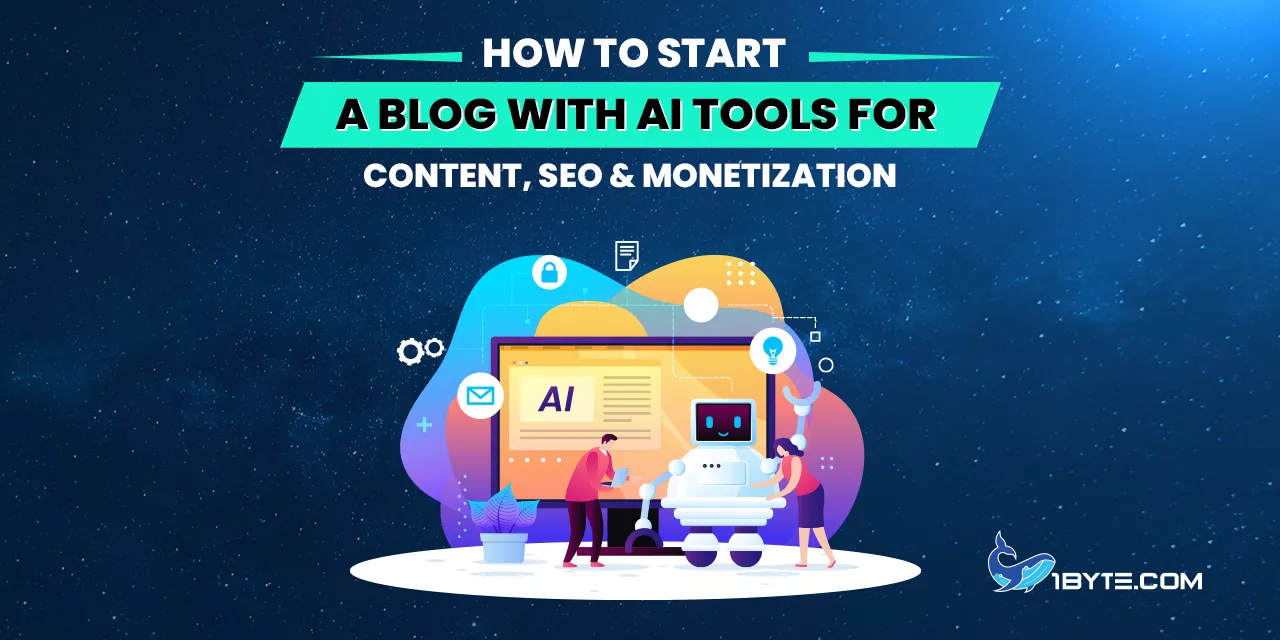- Understand the Modern Blogging Landscape
- Choosing a Niche and Domain With the Help of AI
- Building Your Blog: Platform and Setup
- Writing Blog Posts With AI Assistance
- Optimising Your Blog for Search Engines (AI SEO)
- Monetizing Your Blog Through Advertising
- Monetizing With Affiliate Marketing and Sponsorships
- Creating and Selling Digital Products
- Exploring Additional Revenue Streams
- Practical Steps for Launching Your AI‑Powered Blog
- Conclusion
The idea of launching a blog in 2025 is a great prospect as the blogosphere and artificial intelligence tools would have reached their maturity. The number of blogs worldwide is more than 600 million and it is estimated that 7.5 million more are being posted every day. The bloggers are welcoming AI to do the research work, drafts and even monetize their content, a ratio of only 5 percent of marketers do not use AI tools at all, compared to 65 percent two years ago. This guide from 1Byte delivers a step‑by‑step roadmap on how to start a blog with AI tools for content creation, search optimisation and revenue generation.

Understand the Modern Blogging Landscape
A successful blog starts with realistic expectations and awareness of current trends. Long‑form posts still perform well; the average blog post length in 2025 is around 1,394 words and posts over 2,000 words attract more social shares and backlinks. At the same time, readers’ attention spans are short—U.S. readers spend about 52 seconds on a blog post and 73 % skim articles. Detailed posts must therefore use clear headings, short paragraphs and compelling visuals.
AI adoption among bloggers is now mainstream. A survey by Orbit Media found that the share of marketers who do not use AI has fallen dramatically from 65 % in 2023 to just 5 % in 2025. Another report notes that 90 % of content marketers plan to use AI in 2025, with 71.7 % using AI for outlining, 68 % for content ideas and 57.4 % for drafting. Bloggers who employ AI only for ideation or editing tend to achieve stronger results than those who rely on AI to write complete articles. The message is clear: AI can amplify human creativity, but it should not replace your voice.
Choosing a Niche and Domain With the Help of AI
The first step in how to start a blog with AI is finding a niche that blends passion with demand. AI tools can speed up this research phase:
- Market analysis: AI models such as ChatGPT or Claude can analyze market trends and identify profitable topics. They examine real‑time data, find gaps and suggest audience profiles. For example, you could ask an AI tool to analyze search trends in sustainable travel or remote work to spot sub‑niches.
- Competitor research: AI‑powered keyword tools like AIOSEO’s SEOBoost or Semrush’s Keyword Magic reveal search volumes, competition levels and long‑tail opportunities. AIOSEO’s tool generates topic reports and content briefs for chosen keywords, while Semrush’s ContentShake AI suggests trending topics and keywords.
- Domain brainstorming: AI‑driven name generators evaluate domain availability and brand potential. They combine synonyms and relevant phrases to propose memorable names. After selecting a domain, register it with a reputable registrar and pick a hosting plan.
Building Your Blog: Platform and Setup
After having a niche and a domain, select a blogging platform. WordPress is the most prevalent site that has almost 14 billion views of the page in February 2025. Design and content AI functionality is also available on other platforms, such as Wix. In choosing a platform, the following factors are to be taken into account:
- Ease of use: Platforms like Wix offer drag‑and‑drop editors and AI‑assisted theme designers, making them ideal for beginners. WordPress provides flexibility through themes and plugins.
- SEO capabilities: Ensure the platform allows on‑page SEO optimisation. Tools such as AIOSEO, Surfer SEO and Semrush integrate directly into WordPress to offer real‑time SEO feedback.
- Monetisation readiness: Some platforms partner with ad networks or enable e‑commerce features. Choose a host that can scale as traffic grows.
Once WordPress (or any other platform) is installed, make necessary settings: enable a SSL, install a lightweight theme and develop the home page, about, contact and privacy policy pages. Install, too, an analytics tool and search engine optimization (e.g., Google Analytics) to gather data on the first day.

Writing Blog Posts With AI Assistance
AI writing systems save writing time and increase production. They are however effective when combined with human wisdom. The following are the ways they can be used successfully:
Ideation and Outlining
Most of the marketers apply AI in brainstorming; 71.7% apply AI in outlining and 68% in generating ideas. Such tools as ChatGPT, Claude, Jasper, Notion AI, ContentBot and Surfer AI can come up with title ideas, outlines and bullet points. Get your prompts straight and upfront with your niche, target audience and objectives. As an illustration, request the AI to write a guide on sustainable travel equipment or working at home.
Drafting and Writing
It is just that one out of ten marketers uses AI to create whole articles. Most of the professionals rather engage AI to form a draft and later rephrase it in their own language. Jasper and Writesonic are the tools that can write paragraphs according to your outline. Surfer AI may even create ready-to-rank articles using the analysis of the most successful content in search results. Retain the creative rights by rewriting, elaborating and adding personality to the text written by AI.
Editing and Polishing
Editing is essential. AI text can sometimes be generic or inaccurate. Use grammar tools (Grammarly, ProWritingAid) to correct errors and readability tools like the Hemingway Editor to improve clarity. According to Typeface AI, 86 % of AI users spend time editing AI‑generated content. Add personal anecdotes, data and case studies; cite credible sources; and ensure the tone matches your brand.
Visuals and Multimedia
Pictures are an important part of interaction. According to Orbit Media, posts with statistics, data visuals and quotes of contributors are associated with better results. The AI-driven design system of Canva Magic Design and Adobe Express can generate featured images and infographics based on text prompts. The AI capabilities of Canva are automatic background removal, brand kit and video editing. In the case of videos, artificial intelligence such as Pictory or Synthesia can be used to turn scripts into videos with a voiceover that improve blog posts and social media posts.
Optimising Your Blog for Search Engines (AI SEO)
SEO is one of the obstacles. According to the survey conducted by Siege media, 77.6 percent of content marketers find it difficult to rank content and 70.6 percent find it difficult to fulfill user intent. The use of AI can make the process of SEO easier.
Keyword Research and Content Planning
Search with AI-based research engines to identify keywords with high search volumes and competition that is easy to handle. SEOBoost in AIOSEO offers topic reports containing search volume, difficulty in the key phrase and questions to answer. Semrush and Ahrefs have suggestions of keywords and competitors. Surfer SEO compares high-ranking pages and recommends NLP-based phrases to be added. These tools help to make sure the content matches with the purpose of the user and that subtopics are well addressed.
On‑Page Optimization
AI has the ability to optimize titles, headings and meta descriptions. The Writing Assistant provided by AIOSEO recommends the positions of focus keywords, readability and LSI key words. The SEO Writing Assistant of Semrush analyzes readability and identifies plagiarism. Surfer AI is an app that works with your editor, giving you real-time instructions on word count, the structure of headings and the use of keywords. It is imperative to use the main keyword at the beginning of the title and meta description; use conversational language; and use descriptive alt text on images.
Internal Linking and Structure
The internal links aid the search engines to comprehend the hierarchy of the content and make the site easier to navigate. Internal link suggestions are automated by AIOSEO with the help of the Link Assistant, and the tool as well as tools such as Link Whisper analyze the current content and suggest anchor text. Divide long paragraphs into smaller ones in order to enhance readability and scan-ability (structure articles using descriptive headings H2, H3).
Technical SEO
AI tools check the speed of the site, mobile-friendliness and core web vitals. The lighthouse or page speed insights offered by Google can give an insight into how to do it better. The tools of AIOSEO verify the problems of indexing, and the tools of Screaming Frog and Sitebulb find broken links and redundancies. Make sure that your theme is lightweight and that your images are small; caching extensions and content delivery network (CDN).
Voice Search and Generative Engine Optimization
With the rise of AI search platforms, content must adapt. Exploding Topics notes that AI search visitors are 4.4 times more valuable than organic search visitors and AI search traffic is expected to overtake organic search by 2028. To optimize for generative search, create concise answers to common questions, structure content in question‑answer formats and include structured data (schema markup) to help AI models understand context.
Monetizing Your Blog Through Advertising
Blogs have the potential of being profitable when the traffic and monetization strategies are put into good use. According to surveys, one out of every three bloggers make money out of their blog and approximately 10 out of every 100 bloggers make over 10,000 dollars in a year. Page views are strongly correlated with income: in an income survey conducted by Productive Blogging it was determined that blogs with 50 k -99 k page views generate approximately 5,065 per month, blogs with 100 k -499 k page views generate 9,395, and blogs with 500 k + page views generate 18,950.
Using AI‑Powered Ad Networks
AI can optimize ad placements and maximise revenue. Ezoic is a leading platform that uses machine learning to automate ad and layout optimisation. The platform learns from user behaviour to show more relevant ads, which improves earnings. Ezoic’s Ad Tester automatically tests ad sizes, locations and types, while the Layout Tester optimises website layouts for better user experience. Ezoic’s Big Data Analytics provides insights into which authors, categories and ad sizes generate the most revenue.
Mediavine is a more selective experience. It focuses on user experience and manages the ad placements using programmatic optimisation tools. Blogs that want to be part of Mediavine must have 50,000 monthly sessions. Publift offers tailored advertisement solutions and applies machine learning to optimise ad revenue by bidding ad slots and layout optimisation. Publift boasts of an average growth in the number of ad revenue by 55% to its clients.
Beginners to blogding, use Ezoic since it does not need high traffic (around 10,000 page views per month) and ad testing is also available using AI. Once you start reaching traction, you can switch to Mediavine or Raptive (previously AdThrive) to get higher RPMs and more income.
Diversify Revenue Streams
Display advertising may be insufficient to generate profits. Productive Blogging study reveals that bloggers with multiple revenue streams have superior RPMs; bloggers with five streams or more generate a mean of $62.47 RPM as compared to bloggers with one stream only and an average of 29.79. The same research shows average RPMs of $33.80 adverts, $40.24 affiliate marketing, $51.74 sponsored posts and 283.64 digital products. Diversification is hence a necessity.

Monetizing With Affiliate Marketing and Sponsorships
Bloggers continue to rely on affiliate programs. Affiliate marketing is used by seven out of ten bloggers. Select programs that match your niche like Amazon associates, shareasale or direct brand relations. Find high-paying programs and monitor the conversion rates with the help of AI tools. Link management tools such as ThirstyAffiliates and Pretty Links, which are built on AI, cloak the lengthy URLs and give click data.
Brand collaboration and sponsored posts also can be used to make money. In securing sponsorships, submit media packets with your traffic statistics, demographics and participation rates. The AI analytics provides the opportunity to illustrate in-depth information about the behaviour of your audience and their intent to purchase, which enhances bargaining strengths.
Creating and Selling Digital Products
Digital products offer high revenue potential because they scale without inventory or shipping costs. According to Whop’s 2025 digital products report, digital goods generate over $2.5 trillion in value per year, accounting for about 6 % of combined GDP across studied countries. Furthermore, 68 % of internet users aged 16+ pay for some form of digital content every month. Digital media spending reached $560 billion in 2024, with $282 billion spent on video games, $182 billion on video on demand, $55 billion on e‑publishing and $41 billion on digital music.
Ideation and Market Research
AI tools help to make product ideation more efficient. ChatGPT or Claude is able to analyze niches, find profitable product ideas based on real-time trends and competitor gaps. Research with AI keyword search engines (e.g., Semrush, Surfer) to verify search demand and competition of your possible product subjects.
Product Creation
Artificial intelligence platforms can speed up development. The Leap offers a free AI-powered mini-course creator and email sequence with email marketing, enabling creators to release products fast. Vonza AI develops course curricula within less than 60 seconds based on NLP and data mining; predictive sales funnel optimisation is also provided. Thinkific combines AI to propose the course outlines, monitor the students and find ways to optimize it.
In the case of design assets, Canva uses the Magic Design to automatically generate layouts and visual elements. Midjourney and DALL-E 3 will create images and art to complement your products. In case you make templates, spreadsheets or printables, AI can be used to automate formatting and logic in calculation.
Marketing and Sales Automation
Artificial intelligence-based sales engines optimize funnels. Such tools as HubSpot offer AI lead scoring, customer segmentation and predictive analytics. Mailchimp relies on AI to optimize the time of sending newsletters, audience segmentation and product recommendation. To manage checkout and membership, you can use solutions, such as Gumroad, Podia and Memberful, which are integrated with your site.
Educational and Membership Products
Online learning is projected to reach a value of 842 billion by 2030 with an industry value of $204 billion in 2025. MOOCs earned $23.2 billion in 2023 and it is estimated to earn 483 billion by 2032. It is therefore possible to earn a lot of money by creating courses or membership communities. Courses and community management can be made easier using AI tools such as Thinkific and The Leap, and student support and onboarding can be automated using chatbots.
Exploring Additional Revenue Streams
Beyond ads, affiliates and digital products, consider the following monetization paths:
- Freelance services: Offer your expertise as a consultant or writer. Many bloggers monetize by providing design, coaching or writing services; 35 % of bloggers offer freelance or consulting services.
- Sponsored newsletters: Use email marketing to connect with subscribers. AI can personalise recommendations and subject lines to increase open rates. Offer sponsored placements to relevant brands.
- Membership sites: Create exclusive communities with recurring subscription fees. Only about 6 % of bloggers run membership sites, so there is room for growth. AI community management tools can moderate discussions and deliver personalised content.
- Physical products and merchandising: Use AI‑powered print‑on‑demand services to design and sell merchandise. Integrate with Shopify or WooCommerce to manage orders and inventory.
Practical Steps for Launching Your AI‑Powered Blog
The following step‑by‑step roadmap summarises how to start a blog with ai:
- Define your niche. Use AI to analyze market trends, search volumes and competition. Choose a topic where you have expertise and an audience exists.
- Select a domain and hosting. Use AI tools to brainstorm names and check availability. Register a short, memorable domain and choose a reliable host.
- Pick your platform. For beginners, WordPress and Wix offer flexibility. Install essential plugins for SEO, caching and security.
- Design your site. Choose a responsive theme. Use AI design tools like Canva or WordPress AI theme builders to customize your branding.
- Plan your content. Perform keyword research using AI SEO tools. Create a content calendar with topics, outlines and publishing dates. Aim for long‑form posts over 1,400 words to increase shares.
- Write your posts. Use AI for ideation and drafting, but edit thoroughly. Incorporate visuals, statistics and quotes to enhance engagement. Ensure your tone remains authentic.
- Optimize for search. Use AI SEO tools (AIOSEO, Surfer, Semrush) to refine headings, meta descriptions and internal links. Monitor technical SEO and site performance regularly.
- Promote your content. Share posts on social media. Use AI scheduling tools like Buffer or Hootsuite to post at optimal times. Build an email list and send newsletters with AI‑optimized subject lines.
- Monetize gradually. Begin with AI‑powered ad networks such as Ezoic once you reach about 10k page views. Add affiliate links to relevant products. Experiment with sponsored posts and digital products as traffic grows.
- Diversify income. Introduce online courses, templates, memberships or freelance services. Use AI tools to create and market these offerings effectively.
Leverage 1Byte’s strong cloud computing expertise to boost your business in a big way
1Byte provides complete domain registration services that include dedicated support staff, educated customer care, reasonable costs, as well as a domain price search tool.
Elevate your online security with 1Byte's SSL Service. Unparalleled protection, seamless integration, and peace of mind for your digital journey.
No matter the cloud server package you pick, you can rely on 1Byte for dependability, privacy, security, and a stress-free experience that is essential for successful businesses.
Choosing us as your shared hosting provider allows you to get excellent value for your money while enjoying the same level of quality and functionality as more expensive options.
Through highly flexible programs, 1Byte's cutting-edge cloud hosting gives great solutions to small and medium-sized businesses faster, more securely, and at reduced costs.
Stay ahead of the competition with 1Byte's innovative WordPress hosting services. Our feature-rich plans and unmatched reliability ensure your website stands out and delivers an unforgettable user experience.
As an official AWS Partner, one of our primary responsibilities is to assist businesses in modernizing their operations and make the most of their journeys to the cloud with AWS.
Conclusion
The world of blogging is changing rapidly, and AI is in the centre of this change. The majority of the marketers intend to carry on with AI and 99.6 percent of the users of AI today will still be using AI in 2025. It will be necessary to adapt to AI-driven tools and remain competitive.
However, it still requires human input in order to be successful. Research, drafting and optimisation can be managed by AI, yet authenticity and expertise are appreciated by the readers. By following this guide on how to start a blog with ai, aspiring bloggers can combine AI efficiency with human creativity, build an audience, rank in search and monetise through ads, affiliates and digital products. The possibilities are enormous; through proper planning and proper effort, your AI-driven blog can turn into a successful online company.

